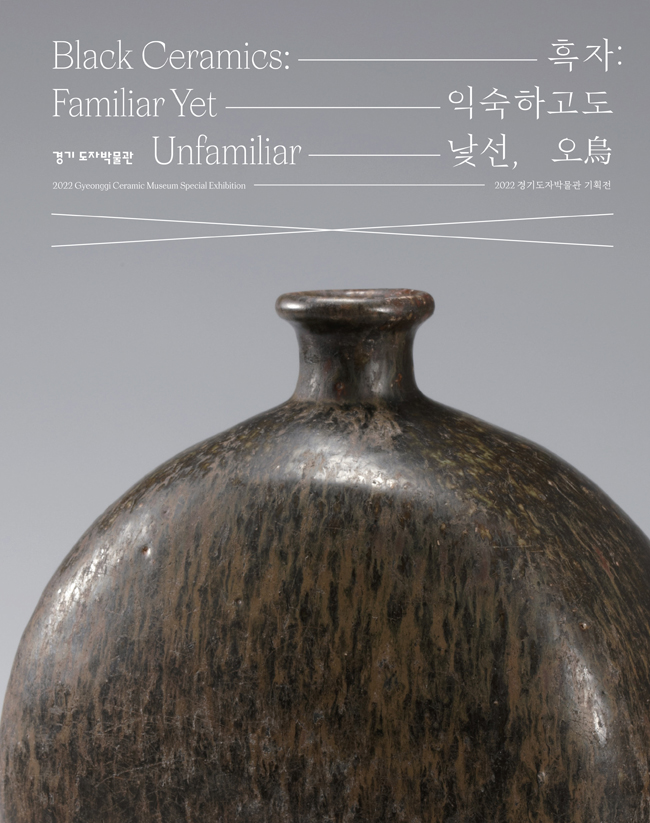서브메뉴
본문내용
- Title : Black Ceramics: Familiar Yet Unfamiliar
- Period : November 29, 2022 ~ March 26, 2023
- Venue : Special Exhibition Hall Gyeonggi Ceramic Museum
- Number of art works : Some 70 works of Black Ceramics and related artifacts are presented

Called by different names, black-glazed ceramics has been continuously produced since Goryeo to the present day. Its tradition has been handed down while undergoing transformation. However, black ceramics has never been representative of a specific era, and it is considered by ordinary people as merely something unfamiliar. In fact, black ceramics has been part of Korean culture throughout much of Korea’s long history. This is evidenced in diverse historical records including Illustrated Travelogue of Goryeo by Xu Jing, a Chinese envoy who visited Goryeo in 1123, An Annotated Bibliography on Agriculture, andFisheries by Seo Yu-gu (1764-1845), a scholar of Practical Learning in the late Joseon period, and Ojuseojong compiled by Yi Gyu-gyeong (1788-1856), which confirms the use of black ceramics at the time. These records allow us to infer that descriptions containing the Chinese character ‘o 烏’ meaning a raven as in the cases of ‘oja 烏瓷’ or ‘o 烏’ followed by ‘vessel name’ are names for black ceramics.
That our Korean ancestors named black ceramics using the letter ‘o (烏)’ for a raven rather than the letter ‘黑’ for black is quite a contrast to white porcelain and celadon, which in Korean are called ‘baekja (白磁)’ and ‘cheongja (靑磁)’ where baek (白) and cheong (靑) mean white and green, respectively. Through these historical records, we can assume that black ceramics has a long history and stories that are unlike those of white porcelain and celadon. It involves much more than simple expression of colors on ceramics. We arranged this exhibition titled Black Ceramics: Familiar Yet Unfamiliar to introduce black ceramics, which has undergone a complex process of development throughout Korean history.
The exhibition has three parts. Part 1 From the Color of Black looks at the nature of black ceramics through historical records and introduces black ceramics of the Goryeo period, when black ceramics began to be widely produced. Together with black-glazed ceramics produced in Korea, imported black tea utensils produced at Chinese kilns such as the Cizhou kilns, Jizhou kilns, and Jian kilns, as well as black-glazed ceramics used as funerary objects before, during, and after the Goryeo period are shown. The artifacts and exhibition materials help the audience look at black-glazed ceramics from various perspectives.
Part 2 Hermit Wearing a Raven tells how black-glazed ceramics came to be called ‘oja’ suggestive of a raven and introduces black-glazed ceramics of the Joseon period, when the shapes and production volume expanded. Part 2 is divided into three sub-themes of Imitation and Renovation, Color of a Raven, and Ceramics in a Pantry to look at diverse aspects of black-glazed ceramics, and deliver the messages contained in the exhibition to the audience easily through special videos.
Part 3 Light, Transformation and Succession features black-glazed ceramics produced in Korea from the end of Joseon period to liberation and introduces materials that enable us to infer the purpose, distribution, and images of black-glazed ceramics. By studying black-glazed ceramics called ‘lacquerware,’ from the Japanese occupation until liberation, in particular, this part sheds light on the background behind the construction and operation of the kilns in Sugwang-ri, Icheon, which were a major production base of modern ceramics in Gyeonggi-do province, and the growth of traditional ceramics in Icheon.
I expect that this exhibition will make known the familiar yet unfamiliar charms and values of black ceramics, which has long been a part of life in Korea, while looking at the history of black-glazed ceramics from its roots to the present day.













 Ceramic Tour
Ceramic Tour





























